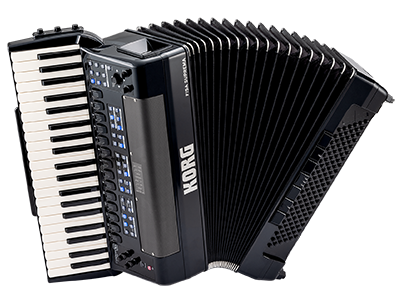

SoundCloud

FISA SUPREMA
AERO DIGITAL INSTRUMENT
Support for Your Purchase
Learn More
Related Products
The Visionary Behind FISA SUPREMA: The Legacy of Tadashi Osanai

From the right is Tadashi Osanai, Tsutomu Katoh and Fumio Mieda
Tadashi Osanai (長内端, 1910-1977), a co-founder of Korg (formerly 京王技術研究所 Keio Electronic Laboratories) and a prodigious accordion player who shone during the Showa era (1928-1989), left an indelible mark on the world of music. His unwavering passion and vision for the accordion were instrumental in the creation of Korg's first digital accordion, the FISA SUPREMA. In tribute to his contributions and creative fervor, we proudly present the FISA SUPREMA.
Tadashi Osanai as an accordion player

After graduating from the Tokyo Imperial University’s Faculty of Engineering, Mr. Osanai began his career as an accordion player. Combining his engineering knowledge with his musical talent, he gained prominence through NHK’s New Performers Competition and later formed the wildly popular "Tokyo Standard Accordion Club". His unique background set him apart from other musicians, captivating audiences with his combination of technical skill and creativity.
Memories of Osanai Sensei - by Fumio Mieda
I chose the title "Osanai Sensei" as that’s how both KORG founder Tsutomu Katoh and all employees referred to Tadashi Osanai as "sensei (Mr.)." I had heard that Osanai sensei was a renowned accordionist before the war, but even though I was close to him, he rarely spoke about the accordion, and I can count on one hand the number of times I heard him play. Even when he occasionally visited the office, he would only give short answers or initiate a conversation himself. However, I still clearly remember the rare instances when he did speak to me.
One day, out of the blue, he asked me an odd question: "Which do you think is better, a Pelton wheel or a Francis turbine for hydropower generation?" Although Osanai sensei was well-versed in mechanical engineering, I specialized in electronics and lacked knowledge of fluid dynamics, so I could only give a vague answer. Osanai sensei never clearly stated why he wanted to know, but I suspect he was considering using a wind turbine to detect the air movement in the accordion’s bellows, convert it to electricity, and control the volume.
There was another similar incident. Shortly after our company released the monophonic synthesizer miniKORG700 in 1973, he again suddenly asked me for detailed information about how the instrument worked. He seemed particularly interested in the connection between the keyboard switches and the sound source. Although electronics were not his specialty, when I explained it using a block diagram, he perfectly grasped the essential functioning of the system. I immediately sensed that Osanai sensei wanted to create an electronic accordion.

(Figure 1) One of the 60 miniKORG700 units used in the experimental concert (with the keyboard removed)
Not long after, he showed me a wiring diagram he had drawn himself and asked if it would work. Although it had many limitations as a regular keyboard instrument, it was an extremely clever polyphonic key assignment method that could be used for accordion keyboards. Though different from modern key assignment methods, it was effectively a polyphonic synthesizer capable of producing seven simultaneous voices. This was during a time when many synthesizer manufacturers were exploring polyphony.
The significance of these two questions became apparent about a year later. Without telling anyone, Osanai sensei had been painstakingly working alone at home, connecting multiple miniKORG700 units together to create a synthesizer accordion.

(Figure 2) Experimental Concert (1975)
Once this became known, it was decided to complete and showcase the project. In October 1975, at a musical instrument fair held at the Science Museum, 60 miniKORG700 sound modules were stacked on stage like a wall and connected to the “Accordix” electronic accordion made by Tombo Musical Instrument, resulting in a grand experimental concert called "One-Man Orchestra" (Figure 1).
About 40 years later, I was astonished to discover a program from one of Osanai sensei’'s pre-war concerts on an online antique book market. It was a program from a concert held much earlier than the 1975 experimental concert, on July 11, 1940 (Showa 15) at Tokyo's Hibiya Public Hall.
The program mentioned the use of a "Special Electric Accordion." The variety of music, from popular tunes to classical pieces like Rossini's William Tell Overture, was reminiscent of the program from the experimental concert 35 years later.

(Figure 4) Sound source unit of the Special Electric Accordion and its creator, Mr. Ibaraki (1940)
Upon further investigation, I found that Osanai sensei, who was recognized as a young prodigy accordionist before the war, had persuaded Satoru Ibaraki of Mita Musen Kenkyusho, a manufacturer of radio equipment at the time, to build an electric accordion.
The term "Special Electric Accordion" likely referred to a hybrid electronic accordion equipped with dozens of vacuum tubes as sound sources. It resembled a modular synthesizer in appearance. Detailed examination revealed it had 24 oscillators and an envelope generator. There were knobs for switching the attack time and sustain time in three stages, making it not only visually but also functionally akin to a synthesizer. 1940 was just five years after the birth of the Hammond organ.
Osanai sensei never spoke to anyone about this. That was just the way he was.
Now, half a century after his passing, I wonder what Osanai sensei and KORG founder Tsutomu Katoh, who supported him throughout his life, would say as they look down from the heavens upon this latest accordion project.
(Figure 2) Music Trade Japan November 1975 Issue
(Figure 4) MJ Musen to Jikken October 1940 Issue




